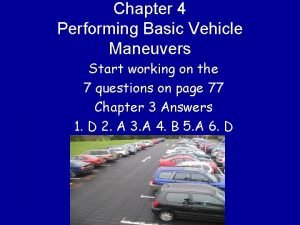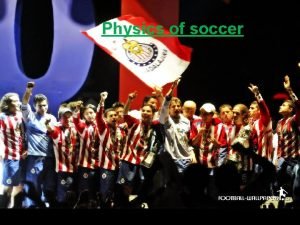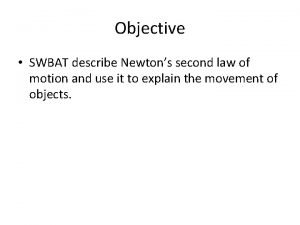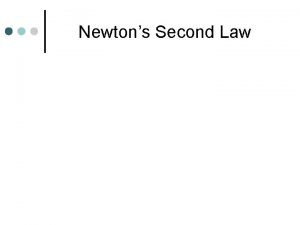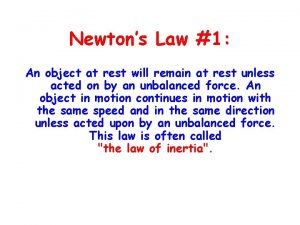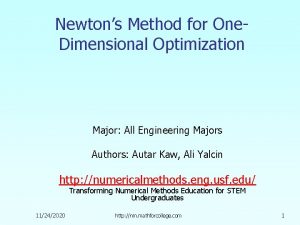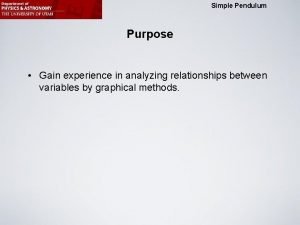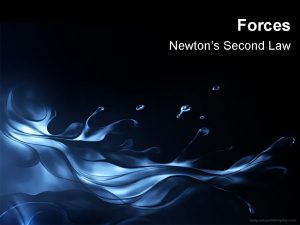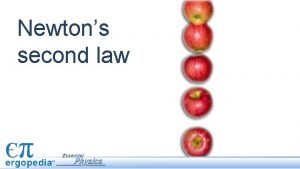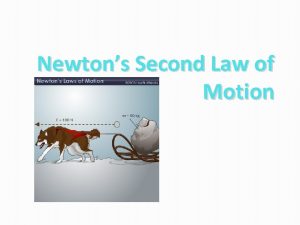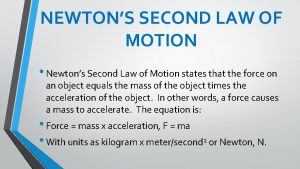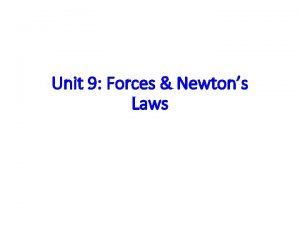Effects of forces Newtons Second Law Starting stopping











- Slides: 11

Effects of forces

Newton’s Second Law • Starting , stopping , getting faster or slower are all changes in motion (acceleration). • Resultant Force is determined using the following formula (Net force = Driving force – Resisting force) • Newton’s second Law : The acceleration of a body is directly proportional the net force acting on the body provided the mass remains constant Equation : F=ma F : Force , m : mass , a : acceleration

The effect of a zero net force • This happens when the driving force = Resisting force • If the object is at rest it will stay at rest • If the object is moving it will keep moving with constant speed Net Force = Zero Acceleration = Zero

The effect of a POSITIVE net force • This happens when Driving forces is greater than Resisting forces • Or there is Driving force with no resisting forces • Object will accelerate (gain speed) Net Force = Positive Acceleration = Positive

The effect of a NEGATIVE net force • This happens when the driving force is less than the resisting force • Or there is resisting force with no driving Force • Object will decelerate (loose speed) Net Force = Negative Acceleration = Negative

Force acting perpendicular to direction of motion • As seen before a force can cause a velocity to change by changing the speed of an object. • Force can cause velocity to change by changing the direction of an object. • Its neither a driving nor resisting force it acts as a Centripetal force • Centripetal force : inward force needed to make an object move in a circular motion

Forces and Deformation • When a force is applied on an object and causes a change in it shape we say it has experienced deformation. • There are two types of deformation: 1. Elastic deformation 2. Plastic deformation

Elastic deformation • When an object experiences a change In shape it returns to its original shape as soon as the force is removed. • Examples: 1. Stretching rubber bands 2. Squeezing a tennis ball

Plastic Deformation • When an object experiences a change in shape and does not return to the original shape when the deforming force is removed • This means this object has exceeded its elastic limit that’s why it didn’t return to its original shape

Hooke’s Law • Hooke’s law : The extension is directly proportional to the stretching force provided that the limit of proportionality is not exceeded • Extension = Stretched length – Unstretched Length Equation : F=Ke F: Forec, K: stiffnes of the string , e : extension

THANK YOU
 Chapter 4 performing basic maneuvers
Chapter 4 performing basic maneuvers Newtons second law in soccer
Newtons second law in soccer Describe newtons second law
Describe newtons second law Newtons second.law
Newtons second.law Newton's 2nd law of motion
Newton's 2nd law of motion Newtons second law
Newtons second law Newtons second law example
Newtons second law example Newton's first law and second law and third law
Newton's first law and second law and third law Newton's first law of motion
Newton's first law of motion Newtons second kaw
Newtons second kaw Newtons second kaw
Newtons second kaw Newtons second laq
Newtons second laq
